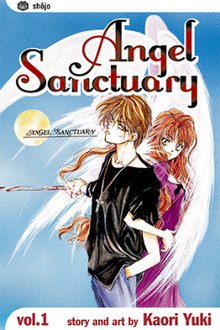| Angel Sanctuary | |
 Cover of the first volume of the English-language translation by Viz Media (2004), depicting Sara and Setsuna | |
| 天使禁猟区 (Tenshi Kinryōku) | |
|---|---|
| Genre | |
| Manga | |
| Written by | Kaori Yuki |
| Published by | Hakusensha |
| English publisher | |
| Magazine | Hana to Yume |
| Demographic | Shōjo |
| Original run | July 20, 1994 – November 5, 2000 |
| Volumes | 20 |
| Original video animation | |
| Directed by | Kiyoko Sayama |
| Produced by |
|
| Music by | Hikaru Nanase |
| Studio | Hal Film Maker |
| Licensed by |
|
| Released | 25 May 2000 – 25 August 2000 |
| Runtime | 30 minutes (each) |
| Episodes | 3 |
| Manga | |
| Angel Sanctuary: Tokyo Chronos | |
| Written by | Kaori Yuki |
| Published by | Hakusensha |
| Magazine | Hana to Yume Ai |
| Demographic | Shōjo |
| Original run | 20 April 2022 – present |
| Volumes | 2 |
Angel Sanctuary (Japanese: 天使禁猟区, Hepburn: Tenshi Kinryōku) is a Japanese manga series written and illustrated by Kaori Yuki. It was serialized in the shōjo manga magazine Hana to Yume from July 1994 to November 2000. It follows Setsuna Mudo, a human teenager who, as the reincarnation of a prominent angel who rebelled against Heaven, becomes entangled in political machinations between the angels and demons. The 120 chapters were collected and published in twenty bound volumes by Hakusensha from February 1995 to February 2001. Titled Coming of the Seraphim in the early stages of its development, Angel Sanctuary was inspired by the Japanese fantasy novel Nocturne and was originally slated to be only ten chapters long, which led Yuki to worry about being able to properly end the story. Angel Sanctuary made cultural references to various mythologies, including Greek and Norse, as well as to real-world people, music, literature, and places.
Viz Media published an English-language translation in North America from February 2004 to June 2007. Angel Sanctuary was also adapted into a series of drama CDs, published from December 1999 to September 2001, and a three-episode original video animation (OVA) by Bandai Visual and Hal Film Maker published in 2000; Yuki assisted on various aspects of both adaptations. Angel Sanctuary was critically and commercially well-received by English-language readers and critics, with Yuki's art and narrative highlighted as its strengths. The OVA received more mixed reviews from critics, who were generally divided on whether they enjoyed it as an introduction to the events of the manga or found its content objectionable due to the sibling incest.
- ^ 『天使禁猟区』白泉社公式WEBくじが本日(9/20)よりスタート。キャラファイングラフ、アクスタ、缶バッジなどのオリジナルグッズが当たる. Famitsu (in Japanese). 20 September 2022. Retrieved 23 October 2022.
- ^ Cite error: The named reference
ANN vol 2was invoked but never defined (see the help page).